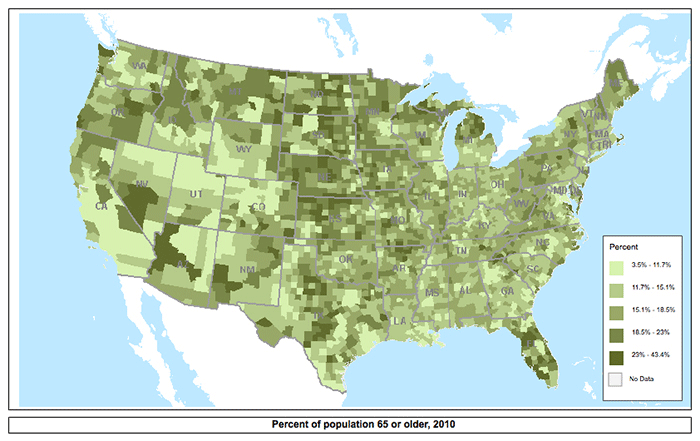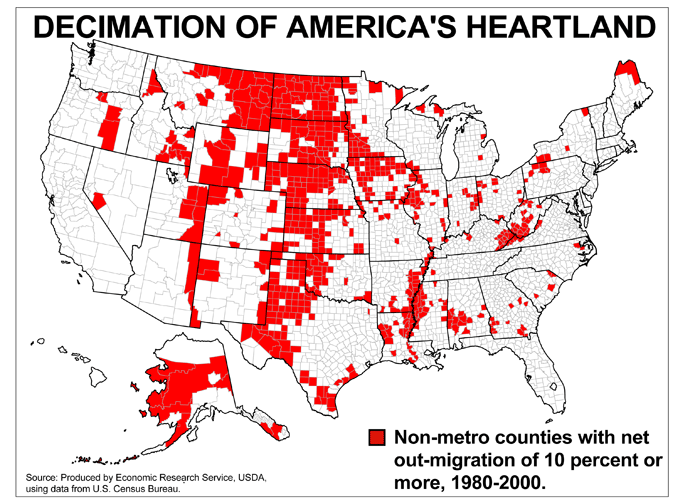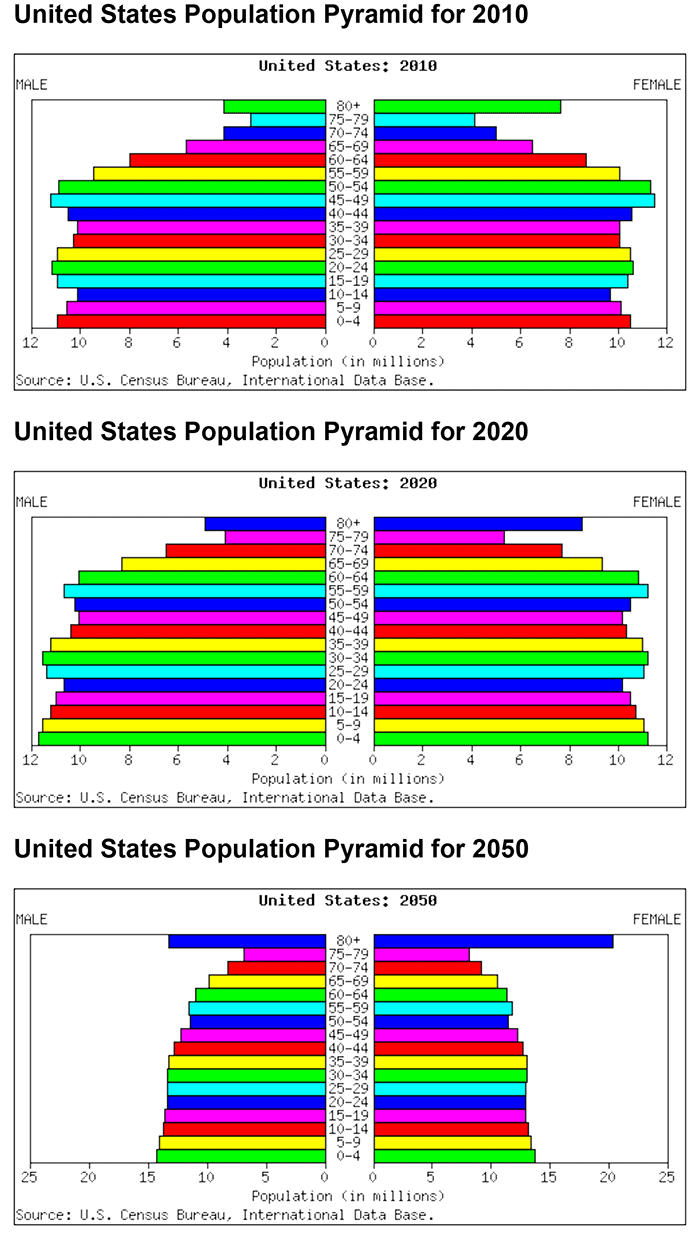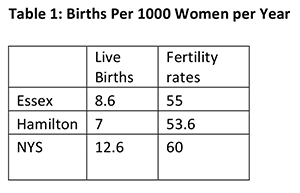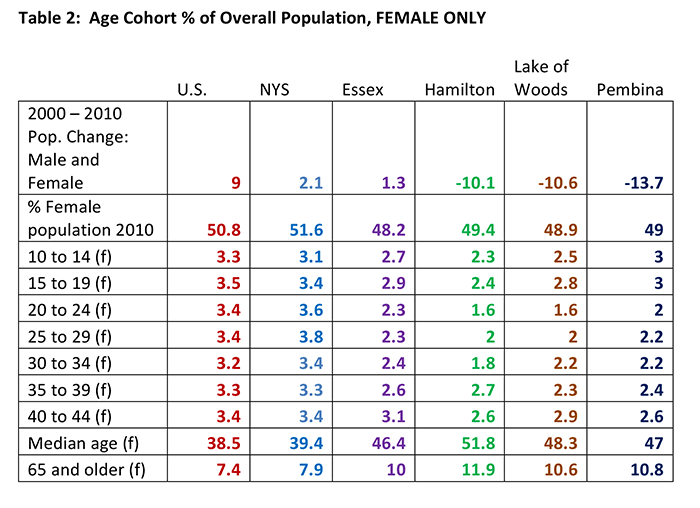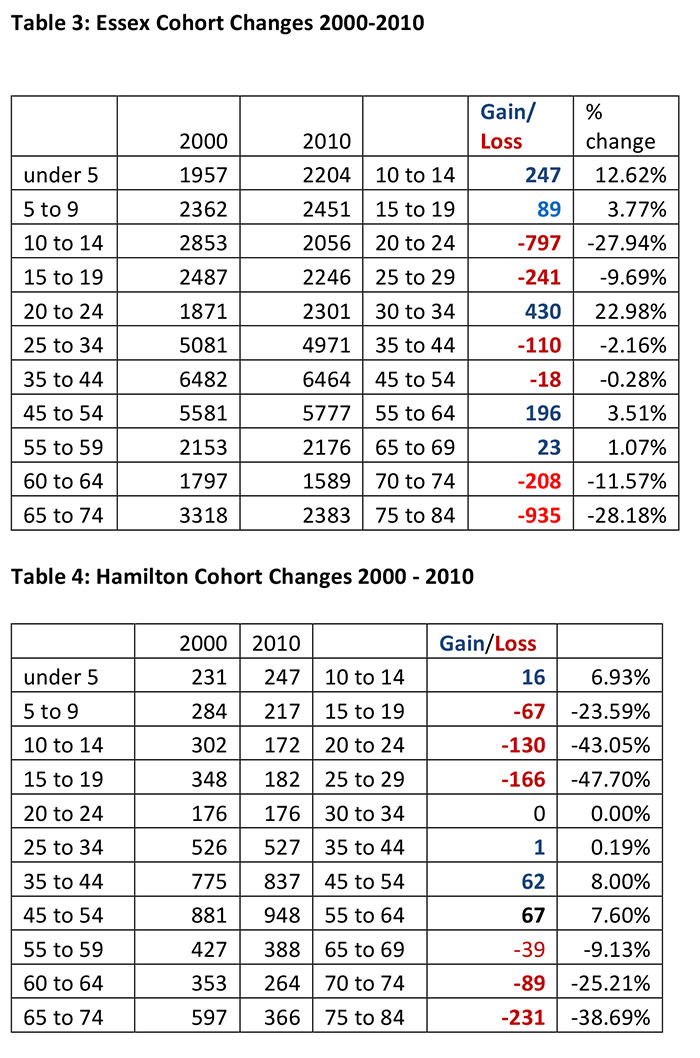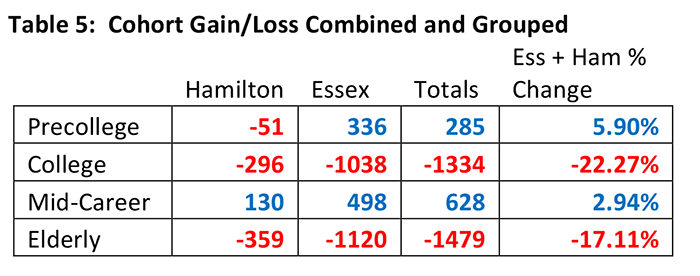Myth: We are aging at a rate that will soon make us the 2nd oldest region is the US. That we are aging rapidly is the result of the out-migration of families resulting from a poor economy, which, in turn, results from excessive public ownership of land and a restrictive regulatory environment.
Reality: We are aging at rates that are typical for rural white populations in the US. Many sparsely settled Northern Forest populations from Maine to Minnesota and the Great Plains agricultural populations are older than we and are likely to remain so. Moreover, aging and population loss are not necessarily a sign of a weak economy. In fact research shows that for rural areas quality of life is the more important factor and that good scenery and access to public lands are major influences on population retention. The fundamental fact of Adirondack demography, however, is the out-migration of college aged young people and that old people die or leave the area for better services for advanced aging. In essence, we educate our children to leave and this out-migration is structural. Urban areas with high divisions of labor are where the jobs are for skilled young people. The Adirondacks have little economic push-out. But we do have a significant mismatch between the jobs sought by college educated people and the jobs to be found here.
The minor population losses in the Adirondack Park are not the result of economic conditions, but rather larger national demographic and social trends
Adirondack communities are old and aging. No doubt. And our median age is greater than that of any state although, as we noted in Myth and Reality Number 1, this has more to do with the fact that we are predominately white population than it does with any facts about our economy. That we are on track to become the 2nd oldest region in the US, as the APRAP Report claimed is, however, unverifiable hyperbole. APRAP does not even tell us how they define a region. However, when one looks at the US based on any sensible definition of a region, there are many areas of the country that are older and losing population more rapidly than the Adirondack Park.
Here’s a map produced by the USDA that shows the percent of county populations 65 years or older.
What can be easily seen in this map is that the counties with large populations of older people are concentrated in the Great Plains, Northern Forest areas, and places such a Florida and Arizona with large concentrations of retirees. Most rural counties are aging.
Most rural counties in the US are also losing population. As the map below shows, the main region that is suffering from population loss is the rural agricultural county region of the Midwest. In a book discussing population loss, Hollowing Out the Middle, Patrick Carr and Maria Kefalas, provide a USDA created map entitled Decimation of America’s Heartland showing the US counties with a net population out-migration of 10% or more from 1980 to 2000. This map (below) shows dozens of counties from North Dakota to Texas that have lost population at this rate. Note that for this period, all counties in the New York North Country and the Adirondacks gained population with the exception of Clinton County, which lost population due to the closing of the Air Force base there. This map itself shows the absurdity of the claim that we are on the way to becoming the 2nd oldest region of the country.
After the 2010 Census the New York Times published an interactive map color-coding counties that lost and gained population. Most of the same Midwestern counties that lost population in the 1980–2000 period lost population from 2000 to 2010. Overall the Adirondack counties gained population from 2000-2010, although Hamilton County lost around 10%. A town-by-town study by the Adirondack Park Agency found that overall the Adirondack Park experienced a 1.3% population loss. For reasons we discuss below about the impact of modern American demographic trends, mild population losses are likely to continue. We have begun to lose population and we will continue to age.
However, the Park’s recent, minor population losses are far less than the 3% losses in a dozen counties in Western New York. The 2010 Census found that over 25% of all New York counties experienced losses. Clearly, from a review of the Decimation of America’s Heartland map or the New York Times map, many areas in the US are aging and losing population. If we stand out among them it is not because our changes are extreme. It is because, as rural areas go, they are modest.
Basic national demographic trends that are driving changes in the Adirondack Park
Notwithstanding, we are old and aging. And the fact that we are aging is a harbinger of steady, minor population losses to come. Older people have fewer children. The real concern about the overdramatized hyperbole of APRAP is that it is unaccompanied by any serious analysis of the nature of population change in the Adirondacks and what it actually means for us.
Below we want to look at some details about this matter. First, some basic demographic concepts:
1. Changes in population are a result of two factors: births minus deaths, and in-migration minus out-migration.
2. Generally, affluence lowers birth rates. Affluent places with little or no in-migration will age and decline. (Japan) And because they are aging their birth rates will be even lower. In contrast, poor places (sub-Saharan Africa and many US Native America reservations) have very high birth rates and young populations. It is a serious mistake to uncritically link aging and population loss to a poor economy.
3. Historic national demographic trends are playing out here in the Adirondacks. Below are three examples of what’s known to demographers as the US Population Pyramid. One shows the results of the 2010 Census. The other two are projections for 2020 and 2050. After WWII the U.S. birth rate soared and then declined producing a large swell in the population (the Baby Boom) that moves through time. This demographic swell (the “pig in the python”) can be seen moving up the pyramid as Boomers age. The Boomer swell is followed by several progressively smaller age cohorts (the Baby Bust). However, because the Baby Boomers were numerous, despite their low birth rate, as they began to have children, they produced another uptick in population (the Baby Burp), which is also moving up the pyramid. As the Boom and the Burp move upward they change in relative size as Boomers die off. In 2010, the population of the US (when represented by population pyramid showing the numbers in 5 year age groups with the oldest at the top) shows bulges for 45-65 and their progeny 15-29.
New York’s population pyramid has the same overall shape with one exception. The US the population pyramid shows that age cohorts under 10 begin again to increase. In NYS the most numerous groups are to be found in the age ranges from 45–49 and 50–54 (the Baby Boomers). The next most numerous group (the Burp) is 20-24. Below this every 5-year age cohort has fewer people. The 20-24 age group in NYS has 1,410,935 and the 0-4 has 1,155,822.
What follows from these facts is that other things being equal populations that have little net in-migration and that have had a Baby Boom and Burp will age, and, as the largest age cohorts leave their child-bearing age, such populations will have fewer babies and more deaths. Thus even relatively stable communities, such as the Adirondacks, will tend to lose populations as they age.
4. And other things are not always equal. In the US some poor communities have unusually high birth rates. Even when they are near places that are aging and losing population, they grow and stay young. Rollette County in North Dakota, for example, continues to grow and has a median age of 30 despite being surrounded by rural counties that are losing population and aging. 70% of its citizens are Native Americans. It is much poorer and has much higher unemployment than the surrounding counties. And in-migration can affect different areas differently too. Places that attract senior citizens may grow and age even with high birth rates. Places that attract Hispanics may grow and stay young. Finally, death puts a ceiling on aging. Very old places will not see continued increases in median age simply because elderly people die at higher rates than younger people. Nature enforces an upper limit on median age.
5. Broadly speaking population migrations everywhere show migration from rural areas to urban areas. Is this because that’s where the opportunities are? This needs to be answered cautiously. Many urban areas have higher poverty rates and unemployment rates than rural areas. Typically urban areas have higher per person and household income than rural areas, especially for college graduates, but this is frequently offset by lower cost of living in rural areas. The real advantage that urban areas have over rural areas, especially in attracting college-educated people, is that they have a more diverse job market and more opportunities for people with specialized talents. This advantage of urban areas over rural areas is structural and has almost nothing to do with the overall availability of jobs in rural areas.
Other factors also affect migration. Cultural opportunities and physical attractiveness are important. Of course, very poor job markets will generate out-migration and booming economies will generate immigration, but absent booms and busts other things become more important. It does not follow from the fact that college graduates and others find more opportunity in urban areas that urban areas have more positive indicators on such measures as poverty or unemployment.
Thus the meaning of an aging population is not in the median. It’s in the details. And, minor population losses are less likely tied to economics than to larger demographic trends.
Impact of low birth rates and fertility rates from loss of college-bound young people
Let’s look at some of these details. Because many Census statistics are presented by county level data we will look at Essex County and Hamilton County since they are fully within the Blue Line.
We will start by looking at birth rates.
What Table 1 tells us is that these Adirondack Counties have dramatically fewer births than elsewhere in NYS. This is to be expected of an older population. There are fewer women of child bearing age (15-45). The fertility rate, however, tells us what the birth rate is for women of childbearing age. Here too Essex and Hamilton are low. So one reason why Hamilton County is aging and losing population and Essex County is aging and has begun to lose population is a low birth rate. But, as we will see below, birth rates are not the main story.
What do we know about the extent to which changes in population are a consequence of births and deaths or of more people leaving than arriving? And who is coming and who is going? Consider Table 2.
The top row shows the total population change between the 2000 and 2010 US Census. Included are figures for two additional counties other than Essex and Hamilton to provide some contrast. Lake of the Woods is a Northern Forest county in Minnesota. Pembina is an agricultural county in North Dakota. Both are small and rural. The figures for age cohorts are for females only. We use women because women are the ones who have children, and because using women tends to cancel out the effects of the prison population in Essex County.
Lake of the Woods and Pembina Counties seem like us in that they are small and sparsely populated. But we should also note that, like many rural agricultural counties in the Midwest, Pembina has been losing population for decades – often at double digit rates whereas Essex and Hamilton Counties have not. Pembina’s population peaked in 1900 at nearly 18,000. It is now just over 7,000. In contrast Hamilton gained population until 2000 and Essex until 2010.
What is most noteworthy about these numbers is that, in the four rural counties, but not in NYS or the US, there is a significant drop off in the percentage of women in the 20-24 age cohort which persists for a decade or more followed by a modest uptick.
This very likely shows two things. First, it means that the main story about population in these counties is that children finish high school, go off to college or the military, don’t return, and are not replaced by others in their age groups. We educate our children to leave. They do. We have a youth drain.
The loss of women in these age cohorts very likely also explains both the low birth rate and the low fertility rate of Essex and Hamilton. There are fewer women of childbearing age, hence a lower birth rate. Also among women of childbearing age it is women from 25-34 who are most fertile. But these women are under-represented among women of child bearing age. Hence there is also a lower fertility rate. We not only have a youth drain. We have a baby drain.
One more observation on Table 2: Unlike the Adirondack Counties, Pembina has been shedding population for decades. Shouldn’t it be older and have a higher percentage of seniors, especially in contrast to Hamilton County? A significant factor here may be that Adirondack communities tend to retain or recruit retirees and seniors to a greater extent than Lake of the Woods and Pembina. From 2000 to 2010, Hamilton added 54 people over the age of 65 and Essex added 920. Lake of the Woods lost 49 and Pembina 185. Thus it is likely that it is out-migration of seniors from Lake of the Woods and Pembina that keeps their percentage of seniors on a par with Essex and Hamilton and lowers their median age. Conversely, retention of older people is a factor in driving up the median age of Essex and Hamilton. Perhaps our aging is, in some measure, a virtue.
How much does out-migration versus a low birth rate contribute to aging and population loss? Recent census data suggests that Essex and Hamilton Counties are among the 1/3 of US counties (mostly rural) where deaths now exceed births. Cornell’s PAD program suggests that over 60% of the population loss of Hamilton County is attributable to more deaths than births. But this does not tell the full story. We need to look at migration and ask who is coming, going, staying, and why?
One way to address these questions is to compare selected age cohorts from the 2000 Census with age cohorts from the 2010 Census that are 10 years older. For example we can compare people who were in the 5-9 age group in 2000 to those who were in the 15-19 age group in 2010. Of course changes can be the result of either migration or death, but we can plausibly assume that death is a minor factor until we get to older age groups.
Here are the results for Essex County and Hamilton County that follow age cohorts from the 2000 Census to the 2010 Census, this time using both males and females. See Tables 3 and 4:
The important patterns here can be more clearly shown by combining counties and collapsing age groups. In the latter case we can use four groups: Precollege (0-9 in 2000), College (10-19 in 2000), Mid-Career (20-54 in 2000), and Elderly (55+ in 2000). See Table 5:
There are three things to notice about these tables.
1. The populations of both counties are relatively stable in the pre-college groups and the mid-career groups. In fact there is modest growth. (Whatever deaths occur in these groups are more than offset by modest in-migration.) The modest growth in the pre-college and the mid-career groups are obviously related since it is the mid-career people who will be the parents of these pre-college children.
We should also note that the stability of the pre-college group is probably underestimated by the fact the students are often 17 or 18 when the leave for college or the military. Because the Census groups people into 5-year cohorts some of those who leave for college are classified as pre-college here.
2. There is a dramatic loss of population in the college group. The cohort that became of college age between 2000 and 2010 declined by over 22%. And here the fact that many of those who go to college are under 20 means that this figure underestimates the out-migration.
3. There is also a significant drop in the elderly group. We assume that this results largely from deaths, but out-migration for health reasons may also be a factor. Recall that we are looking at loss of people within an age group as that group ages. We are not looking at changes in the number of people over 65 in 2000 to 2010. As noted both Hamilton and Essex saw an increase in the number of 65 and older residents.
How should we interpret these findings?
The following are important to note.
1. There is no evidence that there is significant out-migration driven by the lack of jobs in Essex and Hamilton County. Mid-career cohorts are stable over time. And, in fact, various social indicators suggest that we do not have a bad economy. Poverty rates and unemployment rates are generally in line with other rural NYS counties and with NYS itself. (Sometime they are better). We do not have economic push-out.*
2. There is evidence of a significant out-migration of young people who leave to attend college or join the military. Often these people do not return and are not replaced. Is this evidence of a poor economy? We think it is instead evidence of an economy that is mismatched to the aspirations and training of college educated people. Advanced technological societies are characterized by a high degree of division of labor and specialization. These jobs are located in urban areas where employers can find the specialized labor they need in adequate numbers. Colleges train people for these kinds of jobs and their graduates migrate to urban areas where these jobs are. Thus there are structural reasons in advanced economies that explain why sparsely populated small rural communities export young people to urban areas even if they are prosperous. In fact, their prosperity may very well exacerbate out-migration of college-aged people. One characteristic of poor rural communities is that there are more drop outs and a lower rate of college attendance. That is not the Adirondack experience.
3. It appears that we do better than many rural communities in retaining or attracting retirees. Nevertheless, very likely there is some force out related likely to health care for advanced aging.
Thoughts about the future
If we wish to stabilize the Adirondack population and increase employment, the crucial question is “Who can we attract?” We are not going to attract large firms that require significant pools of specialized labor. We might attract very small manufacturing firms that do not require specialized labor and whose products have high value-added. But most high value-added products require specialized labor and we don’t have the cheap electricity in most communities or provide easy transportation. If we want to attract the college-educated (and others of course) there are three groups to emphasize: retirees, telecommuters, and commuters. We might also seek to attract firms who need few unspecialized employees and who produce products or provide services that have high enough value-added to compensate for higher transportation cost. (Our track record here is not good.) And we might look to attract firms that rely on local materials. And, of course, we must nurture our tourist industry.
Finally, we need to keep who we have. Often the college educated work in government jobs – education for example. And governments are among the largest Adirondack employers. Austerity may be something government has forced upon it at this moment in history, but for Adirondack communities it is the enemy of population stability.
(We might also seek to use Hispanics instead of foreign students for summer labor and hope they stay, but that is a topic for another day.)
What is important to emphasize is that very many of the people (and their businesses) we can attract (or keep) will be people who can live where they want or who at least have considerable flexibility as to where they live. Thus what we need to think about and invest in is quality of life. A recent USDA study focused on out-migration in small rural counties. The authors found that in high poverty counties economic factors played a significant role in out-migration. But many reasonably prosperous places (Essex and Hamilton are reasonably prosperous by their definition) also had out-migration in excess of 10% per decade. What made the difference between relatively prosperous counties that lost significant population and those that did not was quality of life. The study concludes:
“Most high net outmigration counties, however, are relatively prosperous, with low unemployment rates, low high school dropout rates, and average household incomes. For these counties, low population density and less appealing landscapes distinguish them from other non-metro counties. Both types of outmigration counties stand out on two measures, indicating that quality of-life factors inhibit in-migration: a lack of retirees moving in and local manufacturers citing the area’s unattractiveness as a problem in recruiting managers and professionals.”
Among the factors that were counted as enhancing quality of life were scenery, access to outdoor recreation, and public land. That low population density is perceived as detracting from quality of life has to do with the ability of a community to support restaurants, cultural events, good schools, and the like.
We are becoming a society in which an increasing percentage of the population can live where they want. Retirees and telecommuters are obvious example. Some people are also able to move established small businesses where they want them. If we want to reclaim college-educated people we need to look to creating communities where people with this kind of flexibility want to live. This will be an older population. Retirees obviously will be old, but telecommuters are likely to be people who have established careers and earned the flexibility to work where they want to live. These are likely to be people who have already established families as well as successful careers and who want to live, work, and raise their families in an attractive setting.
The myth that the Adirondacks is losing population due to its economy has two costs. The first is that those who promote it seek to roll back one of the resources that research has shown is important to the long-term stabilization of the populations of rural areas – well protected, accessible public land. Second, this myth implicitly emphasizes reclaiming jobs in areas such as logging, mining and construction. But the decline in logging and mining jobs has far more to do with mechanization and foreign competition than with the Adirondack Park. In the case of mining, depletion of resources is also a factor. And a focus on the construction of vacation houses is unsustainable and will ultimately detract from the quality of life. To look to expand employment in these places is to address the wrong questions and to find implausible answers. It is also to suggest to most of our children that they should seek their futures in blue collar jobs.
The hard questions we need to ask do not concern population size and aging. They concern quality of life. How do we make our communities attractive places to live for people who can live wherever the please? How big or small these communities ought to be determined by the scale necessary to sustain restaurants, cultural events, good schools, arts centers and movie theatres. And they should not be so big as to generate the factors about urban life that people flee. They need to maintain a small-town feel surrounded by wild lands. Above all, they should not be inconsistent with maintaining well protected, accessible public land.
Perpetuation of this myth that environmental controls are creating a bad economy and are driving out Park residents, such as found in the overhyped APRAP report’s focus on aging or in the commentary of local newspaper editors, represents an attempt to turn back the clock and restore a world that is not coming back. We need a vision for the future.
This article was written and researched by Ken Strike. Ken lives in Thendara, is a Board member of Protect the Adirondacks, and is a professor emeritus from Cornell University.
* There are two anomalies about Essex County that may affect these results. There are 2000 male prisoners in Essex. And there is NCCC. We suspect that these do not significantly alter the overall patterns in Table 5. Prisoners are disproportionately young. While they add to the total population, and may explain some differences when we look at 5 year cohorts, we suspect they do not have much effect on the grouped cohorts. They in-migrate and out-migrate within the mid-career group. They are a wash. Most NCCC students are local and live at home. NCCC, which does not offer a bachelors degree, may defer out-migration for a couple of years thus decreasing out-migration for the 2000 15-19 year old group and increasing out-migration for the 20-24 year old group. The few out of county students may slightly increase in-migration of the 15-19 year old 2000 group. But we do not think these anomalies change the overall pattern, and we think this is conformed, at least in the case of prisoners, by Table 2 which looks only at women.)

